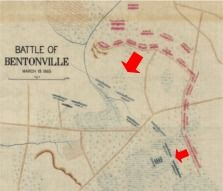The duel between the USS Monitor and CSS Virginia is perhaps the most famous ship action in American history. To many, the fight sounded the death knell of wooden ships and ushered in the era of modern naval warfare. Whether you agree or not, a visit to the USS Monitor Center in Newport News, Virginia is a must for anyone with an interest in the battle of Hampton Roads and the strange new ironclads that fought to a stalemate there in 1862.
The USS Monitor Center is part of the Mariner’s Museum. While I visited mainly to see the center, the larger museum contains hundreds of interesting exhibits and model ships, including a notable gallery on the age of Nelson. Whether you intend to see the entire museum or not, consider a visit. The Monitor Center alone is worth the price of admission.
A full scale replica of the Monitor’s turret stands just beyond the Nelson gallery in the main museum. Near the turret is a Dahlgren replica mounted on a naval carriage. This is an impressive cannon, and I wonder how the battle might have been different had the Monitor’s crew used full instead of half charges for their guns.
Within the center itself are reconstructed officer’s cabins, videos of uniformed reenactors portraying various crew members, and a room containing the red distress lantern the Monitor’s crew hung above the turret shortly before she passed beneath the waves. One room contains a scene of the CSS Virginia in dry-dock. A replica of the bow of this massive vessel stands across the room, and as I moved through the exhibit, I entered by the port side and saw a reconstruction of the inside of the ship and peered through one of the gun ports on the bow.
The Battle Theater presents the story of the battle of Hampton Roads using stunning CGI graphics and surround sound in a three-sided theater – this is truly something to see and was one of the highlights of the visit. Another film details the efforts to raise the turret and preserve various artifacts from the ship, and the center includes a full-scale model of the turret as it was found on the bottom of the ocean, the guns upside-down and everything encrusted with sand and mud and debris. Beside this display is a cutaway model of the turret including one of the massive Dahlgrens mounted on it carriage.
Imagine walking on the deck of the Monitor as she was in 1862 and standing beside the massive gun turret. At the Monitor Center, you can (almost). Just outside the museum stands a full scale replica of the Monitor. I was truly impressed by the size of the ship. Plates on the deck detail various aspects of the ship and its crew.
Back inside the museum, the last gallery of the center focuses on the engines and the area beneath the massive turret. The cutaway replica of the turret stands immediately above. As conservation continues, this area may eventually contain the Monitor’s engines. On the way out, visitors can see the huge tanks containing the Monitor’s turret, engines and guns. Reversing the decay of ages will take several years at the least. Still, as I gazed down at the Dahlgren guns in their murky chemical bath, I was moved by the realization that I stood before one of the guns whose blasts marked the end of the age of sail and ushered in the age of iron.
I planned to spend two hours at the Mariner’s Museum and the USS Monitor Center. I spent five hours there, and it was well worth it. If your next Civil War tour takes you anywhere near Newport News, Virginia, plan to spend some time here.


